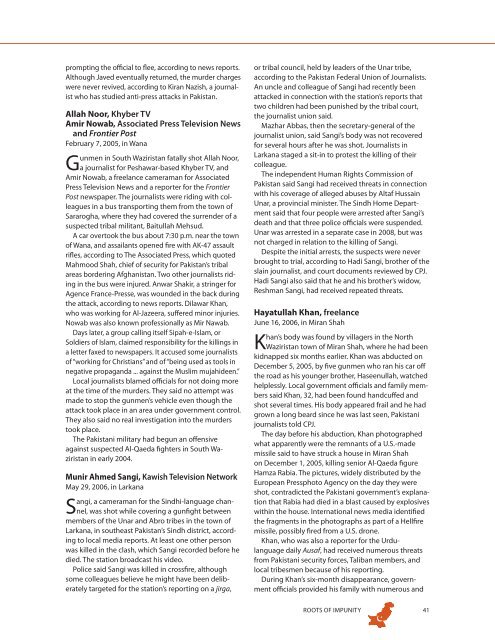CPJ.Pakistan.Roots.of.Impunity
CPJ.Pakistan.Roots.of.Impunity
CPJ.Pakistan.Roots.of.Impunity
You also want an ePaper? Increase the reach of your titles
YUMPU automatically turns print PDFs into web optimized ePapers that Google loves.
prompting the <strong>of</strong>ficial to flee, according to news reports.<br />
Although Javed eventually returned, the murder charges<br />
were never revived, according to Kiran Nazish, a journalist<br />
who has studied anti-press attacks in <strong>Pakistan</strong>.<br />
Allah Noor, Khyber TV<br />
Amir Nowab, Associated Press Television News<br />
and Frontier Post<br />
February 7, 2005, in Wana<br />
Gunmen in South Waziristan fatally shot Allah Noor,<br />
a journalist for Peshawar-based Khyber TV, and<br />
Amir Nowab, a freelance cameraman for Associated<br />
Press Television News and a reporter for the Frontier<br />
Post newspaper. The journalists were riding with colleagues<br />
in a bus transporting them from the town <strong>of</strong><br />
Sararogha, where they had covered the surrender <strong>of</strong> a<br />
suspected tribal militant, Baitullah Mehsud.<br />
A car overtook the bus about 7:30 p.m. near the town<br />
<strong>of</strong> Wana, and assailants opened fire with AK-47 assault<br />
rifles, according to The Associated Press, which quoted<br />
Mahmood Shah, chief <strong>of</strong> security for <strong>Pakistan</strong>’s tribal<br />
areas bordering Afghanistan. Two other journalists riding<br />
in the bus were injured. Anwar Shakir, a stringer for<br />
Agence France-Presse, was wounded in the back during<br />
the attack, according to news reports. Dilawar Khan,<br />
who was working for Al-Jazeera, suffered minor injuries.<br />
Nowab was also known pr<strong>of</strong>essionally as Mir Nawab.<br />
Days later, a group calling itself Sipah-e-Islam, or<br />
Soldiers <strong>of</strong> Islam, claimed responsibility for the killings in<br />
a letter faxed to newspapers. It accused some journalists<br />
<strong>of</strong> “working for Christians” and <strong>of</strong> “being used as tools in<br />
negative propaganda ... against the Muslim mujahideen.”<br />
Local journalists blamed <strong>of</strong>ficials for not doing more<br />
at the time <strong>of</strong> the murders. They said no attempt was<br />
made to stop the gunmen’s vehicle even though the<br />
attack took place in an area under government control.<br />
They also said no real investigation into the murders<br />
took place.<br />
The <strong>Pakistan</strong>i military had begun an <strong>of</strong>fensive<br />
against suspected Al-Qaeda fighters in South Waziristan<br />
in early 2004.<br />
Munir Ahmed Sangi, Kawish Television Network<br />
May 29, 2006, in Larkana<br />
Sangi, a cameraman for the Sindhi-language channel,<br />
was shot while covering a gunfight between<br />
members <strong>of</strong> the Unar and Abro tribes in the town <strong>of</strong><br />
Larkana, in southeast <strong>Pakistan</strong>’s Sindh district, according<br />
to local media reports. At least one other person<br />
was killed in the clash, which Sangi recorded before he<br />
died. The station broadcast his video.<br />
Police said Sangi was killed in crossfire, although<br />
some colleagues believe he might have been deliberately<br />
targeted for the station’s reporting on a jirga,<br />
or tribal council, held by leaders <strong>of</strong> the Unar tribe,<br />
according to the <strong>Pakistan</strong> Federal Union <strong>of</strong> Journalists.<br />
An uncle and colleague <strong>of</strong> Sangi had recently been<br />
attacked in connection with the station’s reports that<br />
two children had been punished by the tribal court,<br />
the journalist union said.<br />
Mazhar Abbas, then the secretary-general <strong>of</strong> the<br />
journalist union, said Sangi’s body was not recovered<br />
for several hours after he was shot. Journalists in<br />
Larkana staged a sit-in to protest the killing <strong>of</strong> their<br />
colleague.<br />
The independent Human Rights Commission <strong>of</strong><br />
<strong>Pakistan</strong> said Sangi had received threats in connection<br />
with his coverage <strong>of</strong> alleged abuses by Altaf Hussain<br />
Unar, a provincial minister. The Sindh Home Department<br />
said that four people were arrested after Sangi’s<br />
death and that three police <strong>of</strong>ficials were suspended.<br />
Unar was arrested in a separate case in 2008, but was<br />
not charged in relation to the killing <strong>of</strong> Sangi.<br />
Despite the initial arrests, the suspects were never<br />
brought to trial, according to Hadi Sangi, brother <strong>of</strong> the<br />
slain journalist, and court documents reviewed by <strong>CPJ</strong>.<br />
Hadi Sangi also said that he and his brother’s widow,<br />
Reshman Sangi, had received repeated threats.<br />
Hayatullah Khan, freelance<br />
June 16, 2006, in Miran Shah<br />
Khan’s body was found by villagers in the North<br />
Waziristan town <strong>of</strong> Miran Shah, where he had been<br />
kidnapped six months earlier. Khan was abducted on<br />
December 5, 2005, by five gunmen who ran his car <strong>of</strong>f<br />
the road as his younger brother, Haseenullah, watched<br />
helplessly. Local government <strong>of</strong>ficials and family members<br />
said Khan, 32, had been found handcuffed and<br />
shot several times. His body appeared frail and he had<br />
grown a long beard since he was last seen, <strong>Pakistan</strong>i<br />
journalists told <strong>CPJ</strong>.<br />
The day before his abduction, Khan photographed<br />
what apparently were the remnants <strong>of</strong> a U.S.-made<br />
missile said to have struck a house in Miran Shah<br />
on December 1, 2005, killing senior Al-Qaeda figure<br />
Hamza Rabia. The pictures, widely distributed by the<br />
European Pressphoto Agency on the day they were<br />
shot, contradicted the <strong>Pakistan</strong>i government’s explanation<br />
that Rabia had died in a blast caused by explosives<br />
within the house. International news media identified<br />
the fragments in the photographs as part <strong>of</strong> a Hellfire<br />
missile, possibly fired from a U.S. drone.<br />
Khan, who was also a reporter for the Urdulanguage<br />
daily Ausaf, had received numerous threats<br />
from <strong>Pakistan</strong>i security forces, Taliban members, and<br />
local tribesmen because <strong>of</strong> his reporting.<br />
During Khan’s six-month disappearance, government<br />
<strong>of</strong>ficials provided his family with numerous and<br />
ROOTS OF IMPUNITY 41


